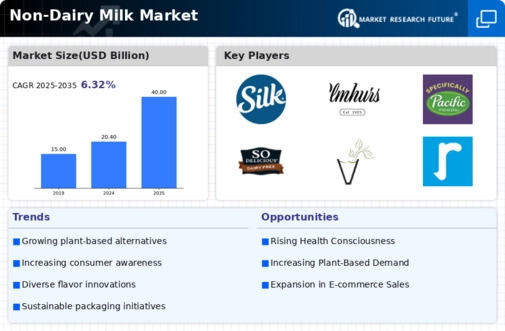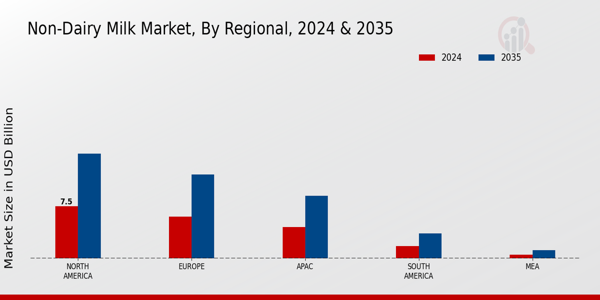Market Growth Projections
The Global Non-Dairy Milk Market Industry is poised for substantial growth, with projections indicating a market value of 20.4 USD Billion in 2024 and an anticipated increase to 40 USD Billion by 2035. This growth trajectory suggests a compound annual growth rate of 6.32% from 2025 to 2035, driven by various factors such as rising health consciousness, environmental sustainability, and changing dietary preferences. The increasing availability of diverse non-dairy milk products across retail channels further supports this expansion, positioning the industry for a promising future.
Diverse Product Innovations
Innovation within the Global Non-Dairy Milk Market Industry is a key driver of growth, as manufacturers continuously develop new flavors, formulations, and packaging solutions. The introduction of fortified non-dairy milks, which offer added vitamins and minerals, caters to health-conscious consumers seeking nutritional benefits. Additionally, the rise of ready-to-drink options and convenient packaging formats enhances accessibility and appeal. This innovative landscape not only attracts new consumers but also retains existing ones, contributing to a projected compound annual growth rate of 6.32% from 2025 to 2035.
Rising Health Consciousness
The Global Non-Dairy Milk Market Industry experiences a notable surge in demand driven by increasing health consciousness among consumers. Individuals are becoming more aware of the health implications associated with dairy consumption, leading to a shift towards plant-based alternatives. This trend is particularly pronounced among younger demographics who prioritize nutrition and wellness. As a result, non-dairy milk options such as almond, oat, and soy milk are gaining traction. The market is projected to reach 20.4 USD Billion in 2024, reflecting a growing preference for healthier dietary choices.
Changing Dietary Preferences
Shifting dietary preferences significantly influence the Global Non-Dairy Milk Market Industry, as more individuals adopt vegan, vegetarian, or flexitarian lifestyles. These dietary choices often stem from ethical considerations, health benefits, or environmental concerns. As a result, non-dairy milk products are increasingly viewed as essential components of modern diets. This trend is likely to continue, with the market projected to achieve a value of 40 USD Billion by 2035, reflecting the growing acceptance and integration of plant-based alternatives into everyday consumption.
Environmental Sustainability
Concerns regarding environmental sustainability play a pivotal role in shaping the Global Non-Dairy Milk Market Industry. Consumers are increasingly aware of the ecological impact of dairy farming, including greenhouse gas emissions and water usage. Non-dairy milk alternatives are perceived as more sustainable options, as they typically require fewer resources to produce. This awareness is driving the adoption of plant-based milks, which are often marketed as eco-friendly choices. The industry's growth trajectory suggests a potential market value of 40 USD Billion by 2035, indicating a significant shift towards sustainable consumption patterns.
Increased Availability in Retail Channels
The Global Non-Dairy Milk Market Industry benefits from enhanced availability across various retail channels, including supermarkets, health food stores, and online platforms. As consumer demand rises, retailers are expanding their product offerings to include a wider range of non-dairy milk options. This increased accessibility allows consumers to easily find and purchase their preferred products, thereby driving market growth. The proliferation of e-commerce has further facilitated this trend, enabling consumers to explore diverse brands and products from the comfort of their homes.






















